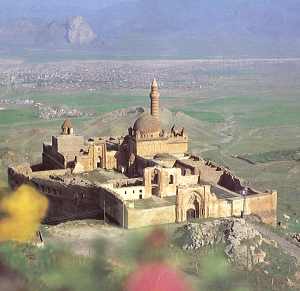|
|
|
|
|
 |
 |
||
|
The palace which was built on a hill at the side of a mountain 5 km east of Doğubeyazıt District is the last large monumental structure of the Ottoman Empire in the Lale Devri period. It is one of the most distinguished and magnificent examples of the 18th century Ottoman architecture and is very valuable in terms of art history. According to the top of the door inscription at the Harem Section it was constructed in 1784 or 1199 according to the Islamic calendar.
As the palace was built in an age when the castles ceased to be special and fire arms were developed and were abundantly available its defense towards the hills on the east is weak. Its main gate is the weakest point in that respect. The structure of the main gate is no different than those seen in the palaces built in İstanbul and elsewhere in Anatolia and has a neat stone workmanship and carving. Today we have very few examples of the historical Turkish palaces still surviving. One of these is the İshak Paşa Palace and complex.
İshak Paşa Palace is composed of following sections in terms of architectural style:
The palace is composed of two courts and the collection of structures positioned around
them. Some of the buildings of the first court are destroyed. The second court which is
surrounded on four sides with buildings has a rectangular plan. To the right, with
reference to the entrance there is the men's quarter and behind it the harem section. At
the end of these, there is the mosque and the mausoleum. The mausoleum is built in the
style of the Seljuk kümbet (cupola) architecture. The palace section has two
storeys. All of its 366 rooms are arranged on these two floors. Each room has a stone
fireplace. The cavities within the stone walls indicate that the building as a whole
possessed a central heating system.The reception hall is 30 x 3 m². It has stone walls
and floor . Its walls are decorated with couplets and verses from the Koran in the
decorative examples of the Turkish Calligraphy art. Among these a couplet, which in very
free trans The interior and exterior architectural wealth of the İshak Paşa palace could be described forever. Whether the palace is taken as a whole or should its rooms and buildings studied individually, success, order and mastery is all that one can fine İshak Paşa Palace stands at a desolate valley today and the fact that it was the subject of various legends and stories add to its magnificent atmosphere some color and mystery.
|
|||